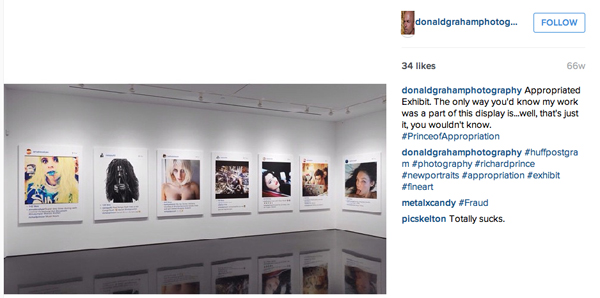
11 Jan Lawsuit May Successfully Challenge Fair Use Defense in Art Appropriation
Artist Richard Prince has made a career out of rephotographing others’ images, earning the ire of photographers and artists. This practice led to an ultimately unsuccessful copyright infringement lawsuit by photographer Patrick Cariou. In that case, the court weighed in favor of Prince, agreeing that for the most part, his appropriation of Cariou’s photos was “transformative” and falls under fair use. This year, Prince is being sued once again for infringement, by photographer Donald Graham. And this time, experts agree that a fair use defense by Prince will have a much dimmer chance of succeeding. The outcome of this case could clarify further the limits of fair use protection in the cases of art appropriation.
Fair use is often cited as a justification for appropriation art. Section 107 of the Copyright Act defines the purposes for which use of a copyrighted work can be considered “fair”: criticism, commentary, teaching, scholarship, research, and reporting news. It also defines four criteria to be considered: the purpose and character of the use (commercial or non-profit); the nature of the copyrighted work; how much of the copyrighted work is used; and the effect the use could have on the potential market for the copyrighted work or it’s value. Fair use is often misunderstood, and there is a grey area of interpretation on what constitutes fair use.
Fair use was cited by Prince as a defense in Cariou vs. Prince. In 2008, photographer Patrick Cariou claimed that Prince violated his copyright in appropriating 35 of his photos for Prince’s Canal Zone exhibit at the Gagosian Gallery. Cariou published his intimate black and white portraits of reclusive Rastafarians in his book Yes Rasta. Prince glued cutouts from the book onto plywood and applied crude overpainting. His defense in the lawsuit claimed that work fell under fair use. While Cariou won an initially in lower court, the United States Court of Appeals for the Second Circuit found Prince’s favor for all but five of the works. (In 2014, Prince and Cariou settled out of court on the remaining five works.)
In the Prince vs. Cariou decision, the court appeared to expand the boundary of fair use. In deciding that Prince’s work was transformative, the court took into consideration “how the work in question appears to the reasonable observer, not simply what an artist might say about a particular piece or body of work.” That interpretation of “transformative” was crucial to Prince’s defense. Ordinarily, an artist’s intention to imbue an appropriated work with new meaning or message is crucial to determining if the work in transformative. However, in his testimony in the original case, Prince stated that he had no such intention. During the appeal, the Warhol Foundation issued an amicus brief, in which they asked the court to consider the “broader art community,” rather than just the artist, to be the reasonable observers of the paintings. The transformative nature of the work would be apparent to that community, presumably art critics, dealers, fellow artists, collectors, and audience.
The Guild strongly disagreed with this interpretation. In an amicus brief filed by the Guild and other arts organizations, the Guild argued that the “reasonable person test” proposed by the Warhol Foundation “would create an unwarranted safe harbor around a small coterie of well-connected elite artists who sell their works for extraordinary prices, at the expense of the greater community of working artists.”
A fair use defense that hinges on such a definition of a “reasonable observer” would have less weight in the current infringement case. This case stems from Prince’s “New Portraits” series, shown at Gagosian Gallery and at The Frieze Art Fair in 2015. Prince appropriated photos posted to Instagram by a wide number of people – models, bloggers, photographers, etc. His reworking of the images was minimal; some images were cropped, and Prince added his own “comment” to the Instagram comments. The exhibit was predictably widely criticized, particularly by photographers. The ire was fanned by both Prince’s press release for the exhibit, in which he claimed “What’s yours is mine”, and by the up to $100,000 price the pieces commanded. It seemed inevitable that Prince would be sued for copyright violation, and in early January, photographer Donald Graham did just that.
At the heart of Graham’s lawsuit is his black-and-white photograph, Rastafarian Smoking a Joint. The photo had been posted to Instagram by a third party, where Prince discovered it and appropriated it. When Graham discovered that his photo was being sold as part of the New Portraits show, he instructed his lawyers to send cease and desist letters to Prince and Larry Gagosian, owner of the Gagosian Gallery. Prince appeared to dismiss the request; Art News reports that in response to a complaint by Graham’s wife about the appropriation, he posted, “You can have your photo back. I don’t want it. You can have all the credit in the world.”
Art News interviewed a number of intellectual property attorneys on Graham’s lawsuit, and they agree that he has a much stronger case than Cariou. They point out the Prince’s modification of Graham’s image was minimal – a slight cropping of the photo on top and bottom and the addition of the Instagram comment – weakening any transformative defense argument. Additionally, Graham copyrighted the photo and sells it as part of an edition through his Paris dealer, A. Galerie, as well as from his studio. (Graham is a well-known photographer who routinely exhibits his photographs in museums and galleries, and sells prints.) Unlike Cariou, who did not generally earn an income from gallery sales, Graham can claim that Prince’s sales of his Instagram appropriation will cut into Graham’s market for that image.
At top of page: What goes around… Donald Graham posted a compaint about the ”Prince of Appropriation” to his Instagram account when he discovered his photograph had been appropriated.
